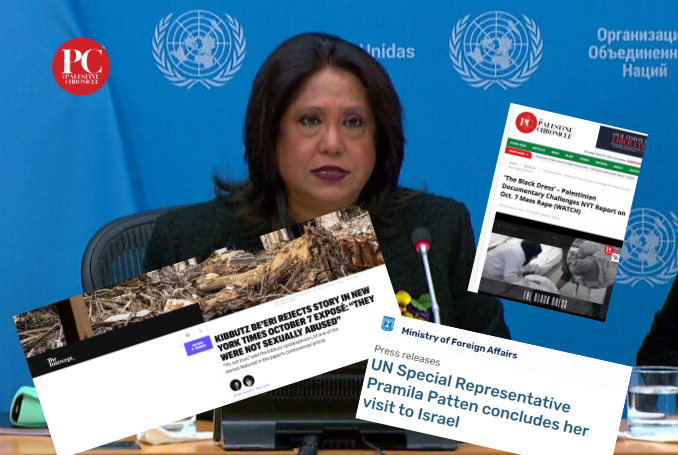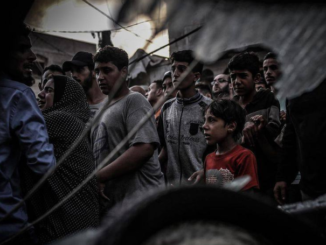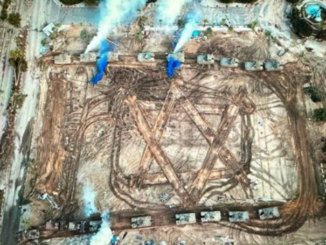
By Blake Alcott
Whatever the motives for the team’s accepting Israel’s invitation to come look at visuals and listen to reports, it has succeeded for now in further demonizing Palestinians, thus making it easier for Israel to continue to commit genocide with impunity.
Judging by mainstream-media coverage of the 4 March 2024 UN report on Conflict-Related Sexual Violence (CRSV), one would think that allegations against Hamas of rape, gang rape and other sexual violence were now no longer speculation but rather proven fact. The report, however, says something radically different.
The UN mission behind the report, headed by Pramila Patten, Special Representative to the Secretary-General on Sexual Violence in Conflict, was in Israel, “at the invitation of the Government of Israel”, from January 29 until February 14, 2024, talking to people in order to find out whether Palestinians committed sexual violence against Israelis on October 7, 2023, in the Gaza Envelope.
It, in fact, found that no single case of sexual violence is proven “beyond reasonable doubt”, that almost nothing meets their own adopted criterion of “clear and convincing” information, and that many allegations which have appeared in the public realm were “unfounded” and/or “could not be verified”. Nevertheless, the mission is pretty sure some rapes occurred.
In its own words: “There are reasonable grounds to believe that conflict-related sexual violence occurred at several locations across the Gaza periphery, including in the form of rape or gang rape, during the 7 October 2023 attacks. Credible circumstantial information, which may be indicative of some forms of sexual violence, including genital mutilation, sexualized torture, or cruel, inhuman and degrading treatment, was also gathered.”
‘Reasonable Grounds’
All hinges on the definition of “reasonable” (grounds) in determining whether “belief” is justified that sexual violence occurred. Aside from the fact that “belief” is itself a much weaker state of mind than for instance “knowledge”, the report never succeeds in laying open its criterion for “reasonable”, much less “credible”, digital or verbal information.
To bolster the claim that what they saw at the morgue, what they heard from people who were supposedly on the scene, and what they saw on “over 5,000 photos and around 50 hours of footage of the attacks” was “reasonably… convincing” or conclusive, the report offers no concrete statements, photos, or audiovisual evidence at all.
Nor does the report even claim to have found a victim of rape: The mission team “did not meet with any survivor/victim of sexual violence from 7 October.” It hastens to explain the absence of directly involved men or women by referring to (presumed) victims’ dispersal throughout Israel or their apparent hesitancy to “come forward”, perhaps due to a “lack of trust” in official bodies. Neither did “first responders (or) health and service providers (sic.)” testify to direct knowledge of sexual violence.
Similarly, “the absence of comprehensive forensic evidence” is explained by said evidence “being spread among various agencies and limited organization of the material” as well as the “destructive burn damage” to many corpses. Direct “audiovisual” evidence is also lacking.
Regarding “information based on photos and videos… that could not yet be linked to a specific location”, their “medicolegal assessment” showed that “no tangible indications of rape could be identified.” But not to worry, “circumstantial indicators, like the position of the corpse and the state of clothing (or) conspicuously spread legs… may alter this assessment in the future.”
In general terms, the report’s section on “Standard of Proof for Verification of (allegations of) Violations” says that their standard of “reasonable grounds to believe”, in itself on the weak end of the spectrum running from ‘rumour’ to ‘proof’, is based on whether the “information” being looked at is “credible and reliable”. However, no criteria for “credible” or “reliable” are given.
For whether information is “clear and convincing” – the other term they apply – the reports admits that “there is no single definition of the term”. The report even admits unabashedly that “the mission was not investigative”.
This, by the way, recalls the admission on February 9, 2024, by New York Times reporter Jeffrey Gettleman, lead author of the discredited December 28 story ‘Screams without Words’, that he did not find “evidence” of mass rape, but only heard “information” about them.
The “reasonable grounds” for the Mission’s “believing” sexual violence occurred thus consist only of some photos of “naked or partially naked” corpses and some “testimony” of people claiming to be “witnesses”. In other words, hearsay.
Their 17-day visit
In their 17 days in Israel, the UN mission met up with President Herzog and “the First Lady”, the Israeli army, Shin Bet, the Israeli Police and the Ministers for Foreign Affairs, Justice, Health, and Welfare and Social Affairs (two Likud, two Shas). They also conducted interviews with 27 “representatives of Israeli civil society” and 34 “victims and survivors” (of the October 7 attacks, not of sexual violence). Prior to arriving they had not been able to get much information because Israel had not made it available.
A ”technical team” supported the mission, consisting of a “human rights” officer, a “police expert in criminal investigation”, a “judicial affairs” officer, a “forensic pathologist”, a “digital and open-source information analyst”, and two each of “sexual and gender-based violence investigators” and “political affairs” officers. They visited the morgue at Shura military base as well as Highway 232, the Nova music festival site, kibbutz Be’eri, and the Nahal Oz military base.
They also visited the occupied West Bank, talking with government officials and others, including four “recently released detainees”, but the report takes no position on the truth of any allegations – described in graphic detail – that Israeli officials have committed sexual violence against Palestinians. They offer no coherent answer to the question why they visited the West Bank at all, and indeed the larger part of this section deals with topics unrelated to sexual violence.
Whether the mission operated in Israel independently, free of government influence, is a matter of speculation, even if the report is frank about the many “limitations” on its “access to survivors/victims (and) first-hand information” and regrets the short duration of its stay. It four times acknowledges the need for “future” or “further” investigation to overcome the inconclusiveness of its findings.
Specific findings
The ‘Disclaimer’ at the top of the report says that “to protect the privacy, safety and security of those who engaged with the mission team”, it is withholding some “sensitive information” and “details”. Whatever the reason, the report keeps this promise to include no details.
Regarding their visit to the first of the “four locations affected by the 7 October attacks”, all they say is that “On Road 232 credible information based on witness accounts describe an incident of the rape of two women by armed elements”.
Other reported instances of rape “could not be verified in the time allotted.” Likewise, along Road 232 “Discernible patterns of genital mutilation could not be verified at this time…” but “the mission team was… able to ascertain that multiple bodies of women and a few men were found totally or partially naked or with their clothes torn…”
Mention of “men” raises the question of whether they had been sexually assaulted, or perhaps been involved in sexual activity at the festival, or had merely been sleeping ‘light’ in the hot weather.
Regarding their stop at kibbutz Be’eri, which we know suffered from Israeli fire, all that is claimed is that there had been “serious reports of CRSV” there. Be’eri “witnesses… adopted over time an increasingly cautious and circumspect approach regarding past accounts, including in some cases retracting statements made previously.” Finally, “At least two of the allegations of sexual violence previously reported were determined by the mission team to be unfounded.” Unfounded for instance is the claim that a pregnant woman’s womb had “been ripped open before she was killed, with her fetus stabbed while still inside her.”
Partially due to “the limited availabilty and low quality of imagery”, “overall the mission team was unable to establish whether sexual violence occurred in kibbutz Be’eri.” (Let us here remind ourselves that the burden of proof lies with those who allege violations: one cannot prove a negative.)
Significantly – in light of Hamas’s claim in its “Our Narrative” document of 21 January 2024 that it’s goal was to kill and capture IDF soldiers, avoiding harm to civilians – at IDF base Nahal Oz the mission found not even reasonable grounds to believe “rape” or “sexual violence” took place. Reports thereof “could not be verified”; instances “could not be established.” It honestly notes that gunshot wounds to genital areas did not constitute a “pattern” because such corpses manifested gunshot wounds to all body areas.
Hamas Document Reveals: Why We Carried Out Al-Aqsa Flood Operation – SUMMARY & PDF
Only concerning the fourth site they visited – that of the ‘Tribe of Nova’ music festival – does the team feel confident in claiming there is “reasonable grounds to believe” sexual violence occurred. Unnamed, not even anonymized, “credible eyewitnesses” reported “multiple incidents of rape, including gang rape”. No reasons are offered as to how these reports met their criterion of “credible”.
The team then baldly adds that “there are further accounts of individuals who witnessed at least two incidents of rape of corpses of women.” Rape of corpses! Because this is merely stated, with no accompanying judgment on whether these accounts are “credible”, much less “verified”, the team must be severely chastised for dancing very close to simple slander.
Three places not visited, but nevertheless commented upon, are first kibbutz Re’im, where the team “reasonably believes” that “digital material” and “witness testimonies” are enough to confirm the rape of a woman “outside of a bomb shelter at the entrance” of the kibbutz. Second, at kibbutz Kfar Aza “verification of sexual violence… was not possible at this point”.
Third, inside Gaza: The Patten team believes that “first-hand accounts of released hostages” constitutes “clear and convincing information that sexual violence, including rape, sexualized torture, and cruel, inhuman and degrading treatment occurred against some women and children…”
Assessing the Report
The report succeeds in leaving associative negative impressions of the behavior of Palestinians on October 7, but in general, regarding a “medicolegal assessment” of testimony, photos and footage, “Given the incomplete overview of evidence at this stage, subsequent investigation… may provide additional insights.” That is, they admit that the jury is still out.
The report must be faulted for often contradicting its own caution. While pertaining to the overwhelming number of allegations at most “reasonable grounds” are asserted to obtain, in numerous places its language assumes stronger claims. §6 of the Executive Summary, for example, speaks of sexual-violence “violations” as if they were established fact. §13 claims that they “verified” the instance of rape outside the bomb shelter at kibbutz Re’im, while §61, dealing with that location, claims only “reasonable grounds to believe”. §48 says “There was a lack of access to first-hand testimonies of survivors/victims of sexual violence.” But how does it then know that they are survivors/victims? In this respect the report is clearly manipulative.
Finally, the short paragraph dealing with ‘Attribution’ deliberately does not seek to say which “specific armed groups” committed the “violations”. It moreover ignores evidence that many Israeli deaths must be attributed to Israeli fire, either from tanks or from the air. It is now clear that Hamas, given the weapons it possessed on 7 October, could not have caused the degree of damage to vehicles along Road 232 shown in readily-accessible photos.
It does acknowledge that Hamas, in its ‘Our Narrative… Operation Al Aqsa Flood’ statement, “has denied claims of harm against civilians” – although in fact Hamas therein admits that “Maybe some faults happened during (the) implementation due to the rapid collapse of the Israeli security and military system, and the chaos caused along the border areas with Gaza. … (I)f there was any case of targeting civilians it happened accidentally and in the course of the confrontation with the occupation forces.” Otherwise, the Operation “targeted the Israeli military sites, and sought to arrest the enemy’s soldiers to pressure… the Israeli authorities to release the thousands of Palestinians held in Israeli jails through a prisoners exchange deal.”
The report moreover records no contact with Hamas in order to hear its opinion on the subject of sexual violence. Hamas, for its part, calls for “fair and independent inquiries” and “a transparent international investigation” into the October 7 events.
In sum, we are being asked to take the word of the mission team. Yet, even if we for the sake of argument do take their word, their report’s “findings” are light-years away from anything meeting the description of systematic or widespread sexual violence being used as a “weapon of war” by Hamas, Islamic Jihad, the PFLP or others. Yet, this has from the get-go been the unproven allegation of, among others, the Israeli Government, the New York Times, and the Guardian – in turn debunked by journalists at for instance the Grayzone, the Electronic Intifada, Mondoweiss, the Intercept, and the Palestine Chronicle – which Google searches will readily confirm.
Common sense must here ask why Israel and its allies have encouraged such a weak report in the first place. After all, if the allegations were true, it would clearly be in Israel’s interest to show any hard evidence it has. Why so timid, if there is anything to this line of defamation? The time to play its trumps would have been now.
At any rate, since the report’s release on Monday, March 4, headlines worldwide have been announcing that rapes committed by Palestinians on October 7 have been “confirmed”. This is not true. Whatever the motives for the team’s accepting Israel’s invitation to come look at visuals and listen to reports, it has succeeded for now in further demonizing Palestinians, thus making it easier for Israel to continue to commit genocide with impunity.

– Blake Alcott is a retired cabinetmaker and ecological economist who has been a solidarity activist since 2010, now living in Zürich. He is Director of ODS in Palestine (UK), an NGO working to make One Democratic State more understandable to the public. His 2023 book, The Rape of Palestine: A Mandate Chronology, consists of 490 instances of the dialogue, such as it was, between the British and the Palestinians during the years 1917-1948. He contributed this article to The Palestine Chronicle







